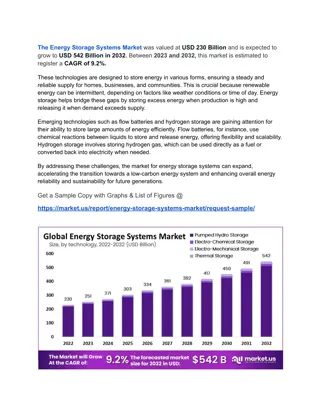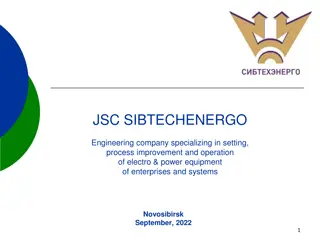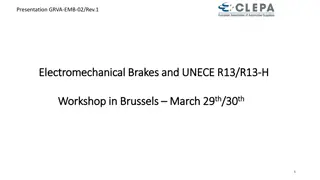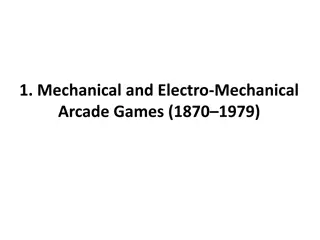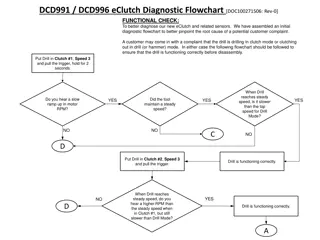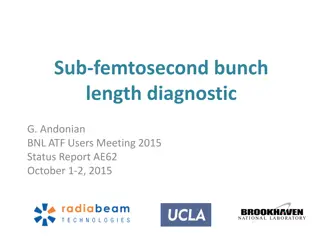
Understanding Electrochemical Cells and Cell Notation
Learn about electrochemical cells, including galvanic and electrolytic cells, their components, functions, and how to calculate cell potential. Understand cell notation for describing galvanic cells and the different ways to calculate the cell's electromotive force (EMF).
Download Presentation

Please find below an Image/Link to download the presentation.
The content on the website is provided AS IS for your information and personal use only. It may not be sold, licensed, or shared on other websites without obtaining consent from the author. If you encounter any issues during the download, it is possible that the publisher has removed the file from their server.
You are allowed to download the files provided on this website for personal or commercial use, subject to the condition that they are used lawfully. All files are the property of their respective owners.
The content on the website is provided AS IS for your information and personal use only. It may not be sold, licensed, or shared on other websites without obtaining consent from the author.
E N D
Presentation Transcript
ELECTROCHEMISTRY ( 2NDLEVEL (CHEM., MICRO-CHEM.& DOUBLED BRANCHES) 234 ) Prof. Ali Yousry El-Etre
Electrochemical Cells The current can flow only between two electrodes with different potentials. Therefore, any electrochemical cell must consist of two electrodes. Every electrode is immersed in an electrolytic solution. The two electrolytic solutions are separated by porous separator. The electrodes ends, which not exposed to the electrolyte, are connected with each other by a metallic conductor. The current will be carried by electrons in the external conductors, whereas, ions carry it in the electrolytic solution.
There are two main types of electrochemical cells according the direction of the electric current. One of these cells is used in production of electric current by chemical reactions. It is called galvanic cell. The other type of cells can produce chemical reaction using an electric current. It is called electrolytic cell.
Galvanic Cell Such as dry batteries, rechargeable batteries during their discharging and fuel cells. The simplest example for galvanic cell is the Daniell cell. The anode is that electrode at its surface the anodic reaction takes place e.g. zinc dissolution. The cathode is the electrode at its surface, the cathodic reaction takes place e.g. deposition of copper. The overall reaction is the sum of the two half- reactions: Cu2++ 2e Cu Zn Zn2+ + 2e Cu2++ Zn Cu + Zn2+
Electrochemical cell notation The following line notation must be considered when describing a galvanic cell: The line notation for the anode is written before that of the cathode. A single vertical line indicates a change in state or phase. The reactants are written before the product, in every half-cell. The concentrations of aqueous solutions are written in parentheses after the symbol for ion or molecule. A double vertical line indicates a separation between two liquids with the diffusion potential is completely eliminated. A dashed line indicates a separation between two liquids with the presence of liquid junction potential (diffusion potential).
Calculation of the cell potential Any one the following two ways could be used to calculate the emf of a galvanic cell: The general way: emf equals to the algebraic sum of the anodic and cathodic electrode potentials. emf = e (anode) + e (cathode) In this equation, the oxidation potential must be used for anodic half-reaction and the reduction potential must be used for the cathodic half-reaction. The European way: emf is the difference between the cathodic and anodic electrode potentials. emf = e (cathode) e (anode) In this case, the reduction potential must be used for both the cathodic and anodic half-reactions. Or the American way: emf is the difference between the anodic and cathodic electrode potentials. emf = e (cathode) e (anode) In this case, the oxidation potential must be used for both the anodic and cathodic half-reactions.
Types of galvanic cells Types of galvanic cells The presence of different reaction conditions at the surfaces of two metals, immersed in the same electrolyte, creates a potential difference between them. The metal with lower potential acts as anode while the other acts as cathode. The whole system, electrodes and electrolyte, is known as galvanic cell. The galvanic cells are divided into three main categories depending on the parameter which cause the potential difference between the electrodes. These are Physical, Concentration and Chemical cells.
Physical cells Physical cells if the one electrode differs in one of its physical properties from the other, a potential difference is established. Allotropic cells Allotropic cells Consists of two electrodes of two modifications of the same metal (M and M ) immersed in a solution of its ion-conducting compound. At a given temperature, only one modification of the metal is stable while the other is in metastable state. The electrode made of the metastable modification (say, M ) possess an increased amount of free energy. It plays the role of negative electrode (anode) in the cell and hence dissolves supplying the metal ions to the solution: M ==== M2+ + 2e At the electrode prepared from the stable modification (M ), metal ions are discharged: M2+ + 2e === M The overall reaction of the cell is a transformation of the meta-stable form to the stable form: M M Knowing the free energy of allotropic transformation, it could calculate the emf of the cell and vice versa.
Gravitational cells Consists of two liquid electrodes, made of the same metal, at different height. An example is a cell made of two mercury electrodes of heights h1and h2where h1 >h2 immersed in a solution of mercury salt HgA. This cell could be represented as follow: Hg (h1) HgA Hg (h2) The electrode of greater height (h1) has higher free energy compared with the electrode of smaller height (h2) and therefore, it dissolves to form mercury ions: 1 2 ??2 +2+ ? ?? ( 1) The mercury ions are discharged at the other electrode where metallic mercury is deposited: 1 2 ??2 The overall process in the cell is the transfer of mercury from the higher electrode to the lower one: Hg (h1) Hg (h2) This spontaneous process keeps on running until the heights of the two electrodes become equal. +2+ ? ?? ( 2)
Concentration cells Concentration cells Concentration cells of the first kind Concentration cells of the first kind Consist of two electrodes of the same material in different activities, immersed in the same electrolyte. An example is the amalgam cells, in which the electrodes differ only in the activity of the metal dissolved in the amalgams. M ( M (??), ), Hg MA M Hg MA M ( (?II II), Hg If aI > aII, the metal dissolves at the left-hand electrode and passes into the solution as the corresponding ions: MHg MHg ( (?I I) === M ) === M2+ The opposite reaction will take place at the right-hand electrode: M M2+ + ze + Hg ===== MHg The overall process in the cell is the transfer of the metal from the concentrated amalgam to the dilute one: MHg MHg ( (?I I) ) MHg The emf of such cell is calculated from Nernst equation as following: ?? ?????? ), Hg 2+ + ze + Hg + ze + Hg 2+ + ze + Hg ===== MHg ( (?II II) ) MHg ( (?II II) ) ? = ???
Gas cells The two electrodes are of the same gas at different pressures. The emf of the cell can be determined from the mechanical work done in transferring one mole of the gas from the high pressure (P ) to the low pressure (P): ?? ??ln? ? = ?
Hydrogen cell ??(? ??),?? ??? ??,??(???) The emf is given by the equation: ?? ??????? ? = ??? Hydrogen gas is ionized at the left-hand electrode. Hydrogen ions are discharged and transferred to gas phase at the right-hand electrode. The positive electric current flows within the cell from left to right. According to the International Convention the cell emf will be positive.
Chlorine cell Cl2 (???? ), Pt HCl Cl2 (????), Pt The emf is: ???????? ? = ?? ???? If P > P, then ionization of chlorine gas takes place at the left-hand electrode. At the right-hand electrode, the chlorine ions are discharged forming chlorine gas. The positive current flows within the cell from right to lift. The emf of the cell is negative.
Concentration cells of the second kind These cells consist of two electrodes of the same metal immersed in the same electrolyte of different activities. It may be cationic or anionic depending on the ions with respect to which the electrodes are reversible. The following cell is an example for cationic cell: K, Hg KCl (?II) | KCl (?I) K, Hg and the following is anionic cell: Ag, AgCl HCl (?II) | HCl (?I) AgCl, Ag Where aI> aII. The overall process takes place in such cell is the transformation of the electrolyte from the concentrated solution to the dilute one.
Such cells are called also concentration cells with transference (or transport). They may be known also as concentration cells with a liquid junction. There is a boundary between the two solutions across which ions are transported and a diffusion potential develops. The junctions can be classified into three distinct types: Two solutions of the same electrolyte with different concentrations, e.g. H2, Pt HCl (a1) | 1 (a2) Pt, H2 with the partial pressures of hydrogen equal on the two sides. Two solutions of the same concentration of one of the ions, but the other ion differs. Other cases. The total cell potential is Ecell = ENernst + Ej where Ej is the liquid junction potential.
Transport number The electrical current is transported through the solution by the movement of the ions. The cations carry the positive charge to the negative electrode and the anions carry the negative charge to the positive electrode. Thus, the total current passes through the solution (I) is divided between positive and negative ions. In some cases, one has to know the fraction of the total current carried by a particular ionic species. This value is known as the transport number or the transfer number of positive (t+) or negative (t-) ions. The transport number can be defined as: t+ = I+/I t- = I-/I for positive ions for negative ions
For binary electrolyte we can write the transport number in terms of ionic motilities (conductance) as: ? ?+ ? for positive ions ?+= ?+ ? ?+ ? ? ? for negative ions. ? = ?+ ? ?+ Where ? ?is the equivalent (molar) conductance at zero concentration which is the same at infinite dilution (? ? = ? ) It is obvious that: ?+ ? ?= ? ?+ For any electrolyte as well as for solutions containing several electrolytes, the transport number of an ionic species (I) is expressed by the equation: ?? ?? and in this case: ??= ??= ?
Liquid junction potential Liquid junction potentials are the result of different cation and anion mobilities under the influence of an electric field. The potential manifests itself in the interface between two different solutions separated by a porous separator or by a membrane. Consider, for example, a porous membrane separating solutions of 0.1 M HCl and 0.01 M HCl.
Because the concentration of HCl on the membranes left side is greater than that on the right side of the membrane, H+ and Cl diffuse in the direction of the arrows. The mobility of H+, however, is greater than that for Cl . Thus, the solution on the right side of the membrane has an excess of H+ and a positive charge. Simultaneously, the solution on the membrane s left side develops a negative charge due to the excess concentration of Cl . This difference in potential across the membrane is called a junction potential, which is represented as Ej.
Salt bridge Used to eliminate the junction potential of the cell. It is a u-shaped tube contains a solution of an electrolytic salt. It placed Inverted so as each tip is immersed in one electrolyte of the cell. So, it provides an ionic connection between the two electrolytes. two junction potentials are developed at both tips of the bridge with the same magnitude and reverse sign. Thus, the overall junction potential is zero.
EMF of the concentration cells of the second kind Anionic cells Ag, AgCl HCl (? I) | HCl (?II) AgCl, Ag If aI > aII, the silver electrode in the lift side which is in contact with the higher Cl-concentration is the anode. Thus, the reaction at the left-hand electrode is the dissolution of silver metal as a result of its combination with Cl- ions: Ag + Cl- (I) ==== AgCl + e Cl-ions are generated in the left side by the cathodic reaction: AgCl + e ==== Ag + Cl- (II) The overall reaction is transport of Cl- from the left higher concentration to the right lower one: Cl- (I) ==== Cl- (II) The emf of such cell is: ?? ???????? ? = ?????? The electronic current passes from the anode (left side) to the cathode (right side). The Cl- ions diffuse through porous diaphragm from the region of high concentration (right side) to the region of lower concentration (left side).
Cationic cells K, Hg KCl (?II) | KCl (?I) K, Hg If aI > aII, the K(Hg) electrode in the lift side which is in contact with the lower K+ concentration is the anode. K === K+ (II) + e the K(Hg) electrode in the right side which is in contact with the higher K+ concentration is the cathode. K+ (I) + e === K And the overall reaction is: K+ (I) === K+ (II) Then we have the emf as: ?? ???????? ? = ??????
Ion-selective electrodes and bio-membranes If it were possible to have an interface permeable to only one ion (say H+), then the transport number of that ion would be unity and ??? ???? + RT ?ln ??= + or, in general, for an ion (i) of charge z, RT ???ln??? ??= ???? The corresponding liquid junction potential (??)is called themembrane potential. Ideally (??) changes in a Nernstian fashion with the activity of the ion in one of the phases, the activity in the other phase being held constant. This is the basis of the functioning of ion-selective electrodes and bio-membranes.




